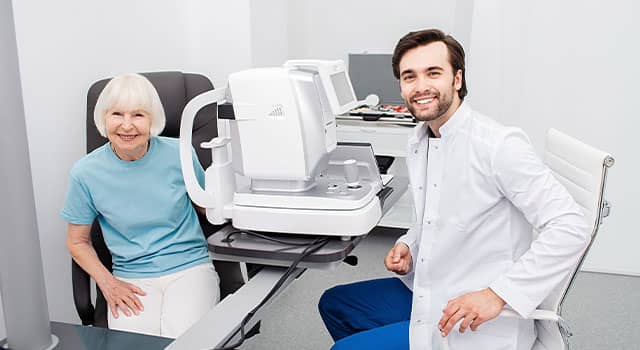 A wide range of factors can lead to vision loss and the speed at which your vision deteriorates. For certain patients, changes to vision can occur quickly, as a result of eye diseases like untreated retinal detachment, wet macular degeneration or eye trauma. In other cases, vision loss is often very gradual, developing over many years and even decades, as in the case of open-angle glaucoma and dry macular degeneration.
A wide range of factors can lead to vision loss and the speed at which your vision deteriorates. For certain patients, changes to vision can occur quickly, as a result of eye diseases like untreated retinal detachment, wet macular degeneration or eye trauma. In other cases, vision loss is often very gradual, developing over many years and even decades, as in the case of open-angle glaucoma and dry macular degeneration.
Adjusting to visual impairment takes time and patience—but you don’t have to go through it alone. We can help. Below, we offer some tips to help you or a loved one with any degree of vision loss live a more fulfilling, independent and enjoyable life.
1. Visit a Low Vision Optometrist
Low vision optometrists are experienced in working with people who have low vision. They offer a low vision evaluation to determine how much vision you have and assess which tasks are giving you trouble. They will then prescribe low vision glasses and devices to allow you to do what you want to do.
2. Give your eyes a break
Eye fatigue is a very real and common side effect of vision loss. Many sight-threatening eye diseases cause symptoms like reduced color contrast, color and shape distortion, and light and glare sensitivity, among others.
All of these symptoms put a great deal of stress on the visual system since your brain works overtime to try and make sense of the distorted images your eyes are sending.
Make sure that your eyes are getting the rest they need by closing them for a few minutes at a time throughout your day, especially during visually taxing activities. Many patients also find it helpful to take power naps when possible.
3. Don’t be afraid to ask for help
Although it may be hard at first, asking for help from family, friends and even strangers may be necessary at any stage of vision loss.
We understand that asking for assistance may feel uncomfortable, but truth is—most people are happy to offer a helping hand.
4. Try slowing down
Moving at the same pace you once did can be dangerous after vision loss sets in. Give yourself the extra time you need to complete tasks, both routine and unfamiliar ones.
For example, if you’ve dropped an object, bend down slowly and cautiously to avoid accidentally bumping your head into something along the way.
5. Keep things [organized]
If it feels like you’re spending too much time trying to locate objects around the house, you may need a better organization system.
Keeping things in a set place will save time and energy. It also fosters independence and [minimizes] daily stress.
Using bold-colored labels, puffy paint, stickers, pins, and filing systems can all help keep objects neat and easily accessible.
Customize your [organizational] system to suit your needs — and stick to it. It will take some getting used to at first, but will ultimately be worth the effort.
6. Start relying on your other senses
Using your other senses like touch and hearing can be incredibly helpful when trying to get things done.
Using your hearing to detect an oncoming vehicle at a crosswalk will help you better navigate the road. Or using your hands to scan a surface when looking for your phone or keys can be more effective than trying to spot them visually.
Whether you’ve been living with low vision for a while or have received a recent diagnosis, we can help. At Low Vision Optometry of Southern California, we understand the challenges that accompany low vision and make it our mission to improve the lives of our patients so they can live a more independent life.
If you or a loved one has experienced any degree of vision loss, call Low Vision Optometry of Southern California today to schedule your low vision consultation.
Low Vision Optometry of Southern California serves patients from Riverside, Orange County, Temecula, Mission Viejo, and throughout California.
Q: #1: What is low vision?
- A: People with low vision can achieve no better than 20/70 vision, even with glasses, contact lenses, or surgery. Low vision is typically caused by eye injuries and eye diseases, among other factors.
Q: #2: What are low vision aids and devices?
- A: Low vision aids are a combination of special lenses and devices that maximize any usable vision to help patients read, recognize faces, watch TV, and carry out daily tasks. Common low vision aids include low vision glasses like telescopes, microscopes, prisms, filters, electronic visual aids and optical magnifiers. Your low vision eye doctor will work with you to prescribe the most effective devices for your needs.
